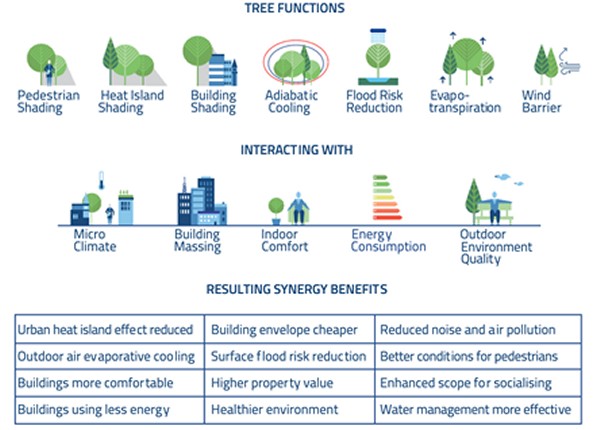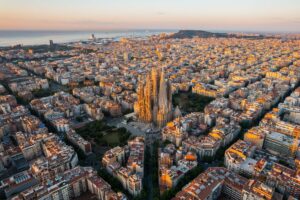What is urban planning?
Urban planning is the process of designing and organising the development of cities and towns. Urban planning dates back to ancient civilizations and has evolved over time to become a critical component of modern city planning 1Urban Design Lab, “Ancient Cities, history of urban design, history of urban planning, urban design history.” March 11, 2023. https://urbandesignlab.in/history-of-urban-design-from-ancient-to-modern-cities/. It involves managing the use of land and resources in an urban environment to create efficient, sustainable, and functional spaces for people to live, work, and play. Urban planners focus on a wide range of elements including transportation systems, housing, public spaces, environmental protection, and economic development.
Urban planning and management must navigate and adapt to the evolution of cities, both physically and socially, as it is the only way to ensure resilience towards global changes such as climate change. Conventionally, urban planning has been considered a top-down approach, however, over time urban planning has begun focusing on social and environmental issues to help improve quality of life and wellbeing following a sustainability framework 2Milad Haghani, et al., “The landscape and evolution of urban planning science,” Cities, Volume 136, 2023. Essential to urban planning today is balancing the increasing urban community’s needs with economic and environmental considerations for future growth and challenges. New paradigms such as smart growth, compact cities, just cities, resilient cities, and smart cities are some examples 3Haghani, et al., “The landscape and evolution of urban planning science”.
Why is a system-based approach to urban planning important?
The city is a complex system of processes and sectors that are inextricably intertwined, and these must be approached in a holistic manner to optimise overall improvements and harness synergies. A single action in a process or sector can impact and influence other processes and sectors, both positively and negatively. As such it is essential not to isolate individual actions and only measure their progress against single objectives, but rather apply a system-based approach and identify all impacts on all affected processes and sectors before deciding to introduce a given change.
The Blue-Green approach (BG Solutions) is one of many examples of systems-based approaches to urban planning. The BG solutions strive to harness the synergy benefits between urban components and ecosystem services [FIG 1] with the objective of implementing efficient and cost-effective, multifunctional urban solutions 4Ranko Bozovic, et al., “Blue Green Solutions. A Systems Approach to Sustainable, Resilient and Cost-Efficient Urban Development.” March, 2017. DOI:10.13140 / RG.2.2.30628.07046.

FIG 1. Urban components and ecosystems services 5Ranko Bozovic, et al., “Blue Green Solutions. A Systems Approach to Sustainable, Resilient and Cost-Efficient Urban Development.”
Using the example of greening the city, it is important to consider the multi-functionality of a tree. In addition to the tree’s aesthetic value, its benefits include urban heat island mitigation (via both shading and evaporative cooling), storm water flood risk reduction, noise and air pollution reduction and acting as a wind barrier. These functions interact with the urban microclimate, building massing, indoor comfort, energy consumption and outdoor environmental quality 6Ranko Bozovic, et al., “Blue Green Solutions. A Systems Approach to Sustainable, Resilient and Cost-Efficient Urban Development.”.
In many cases, the tree’s functions can be enhanced/maintained without excessive use of potable water: for example, by irrigation with harvested roof and street rainfall runoff and recycled grey water. If integrated adequately, many synergy benefits will result. Under the BG Systems approach these interactions are modelled and quantified to inform the choice and positioning of trees for the area. This includes careful selection of the tree species based on their characteristics and the specific requirements they will need to fulfil 7Ranko Bozovic, et al., “Blue Green Solutions. A Systems Approach to Sustainable, Resilient and Cost-Efficient Urban Development.”.

FIG 2. The multi-functional interactions and benefits of a tree
Read the full Blue Green Solutions. A Systems Approach to Sustainable, Resilient and Cost-Efficient Urban Development Report
Who is responsible for what in urban planning?
Urban planning is a collaborative effort that requires collaborative planning (co-planning) from a diverse set of professionals and stakeholders depending on the scope and scale of the planning activities.
Co-planning can be broken down into the following four phases:
- co-assessment, planning and exploration
- co-design and experimentation
- co-implementation and maintenance
- co-monitoring and co-evaluation
The last two phases are often neglected or totally forgotten but are crucial parts of the co-planning process 8Forum Virium Helsinki, “The Collaborative Planning Process.” B.Green Handbook, 2022. https://bgreen-handbook.eu/the-collaborative-planning-process/.
To learn more about the four phases go to the Green Handbook and explore some of the many cases: https://bgreen-handbook.eu/
It is usually the local authority that is responsible for managing the urban planning process through a dedicated planning department. They establish relevant rules and regulations, develop local plans, and oversee land use in their jurisdictions. Where projects go beyond local authority jurisdiction, it may be relevant to involve certain regional and national agencies to ensure efforts align with regional and national policies and regulations.
Where needed, specialised professionals are called upon for input. This includes urban planners, architects, engineers, economists and social and environmental scientists. Some are employed directly within the local authority while others are subcontracted for their services. Such professionals are essential in conducting key research and optimising the design of development plans and making sure the implementation is done properly while ensuring functionality and safety.
Community engagement is absolutely essential in ensuring effective urban planning. This includes residents, business owners, and other local stakeholders who have a vested interest in how their cities are developed 9Vanja Pantic, “How Copenhagen got 12,000 residents to participate in large-scale Proposals project in just 4 months.” Citizenlab, 2024. https://www.citizenlab.co/blog/case-study/copenhagen-proposals-12000-residents-participate/. Public participation helps in making the planning process more democratic and responsive to the needs of the community.
- Learn more about Urbanisation and the future of cities
- Learn more about the statistics around Urbanisation
- Learn more about the History of Urban Design: From ancient to Modern cities
- Learn more about How to Make an Attractive City
- Learn more about Systems Approach to Sustainable and Cost-Effective Urban Development
Real World Examples
 Barcelona 10David Roberts, “Barcelona’s remarkable history of rebirth and transformation – How the city grew, from pre-Christian Romans to Cerdà to the 1992 Olympics.” 2019: https://www.vox.com/energy-and-environment/2019/4/8/18266760/barcelona-spain-urban-planning-history
Barcelona 10David Roberts, “Barcelona’s remarkable history of rebirth and transformation – How the city grew, from pre-Christian Romans to Cerdà to the 1992 Olympics.” 2019: https://www.vox.com/energy-and-environment/2019/4/8/18266760/barcelona-spain-urban-planning-history
Barcelona is renowned for its unique and innovative urban planning, particularly famous for the 19th-century “Eixample” plan designed by Ildefons Cerdà. However, both before and after Cerdà, Barcelona has undergone urban transformation.
This goes back to the first human settlers as early as 5000 BC, through the Roman settlements, followed by the Visigoths and Arabs into the region capital of Catalonia that it is today.
- Watch this video to understand Why Barcelona Looks Weird
- Learn more about Barcelona’s Car-Free Superblocks
- Read about Barcelona’s green infrastructure and biodiversity plan 2020
Bibliography
- Bozovic, Ranko & Maksimovic, Čedo & Mijic, Ana & Smith, Karl & Suter, Ivo & Van Reeuwijk, Maarten. “Blue Green Solutions. A Systems Approach to Sustainable, Resilient and Cost-Efficient Urban Development.” 2017. 10.13140/RG.2.2.30628.07046.
- David Roberts, “Barcelona’s remarkable history of rebirth and transformation – How the city grew, from pre-Christian Romans to Cerdà to the 1992 Olympics.” 2019. https://www.vox.com/energy-and-environment/2019/4/8/18266760/barcelona-spain-urban-planning-history
- Fainstein, Susan S. “Urban Planning”. Encyclopedia Britannica, 29 Apr. 2024. https://www.britannica.com/topic/urban-planning
- Forum Virium Helsinki, “The Collaborative Planning Process.” B.Green Handbook, 2022. https://bgreen-handbook.eu/the-collaborative-planning-process/
- Haghani, Milad, Soheil Sabri, Chris De Gruyter, Ali Ardeshiri, Zahra Shahhoseini, Thomas W. Sanchez, Michele Acuto, “The landscape and evolution of urban planning science,” Cities, Volume 136, 2023.
- Pablo Vaggione , “Urban Planning for City Leaders.” UN HABITAT, 2014.
- Urban Design Lab, “Ancient Cities, history of urban design, history of urban planning, urban design history.” March 11, 2023. https://urbandesignlab.in/history-of-urban-design-from-ancient-to-modern-cities/
- Vanja Pantic, “How Copenhagen got 12,000 residents to participate in large-scale Proposals project in just 4 months,” Citizenlab, 2024. https://www.citizenlab.co/blog/case-study/copenhagen-proposals-12000-residents-participate/
- “World Cities Report 2022 – Envisaging the Future of Cities,” UN HABITAT, 2022.

